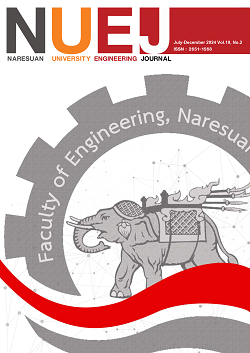Investigation Seismic Response in Phitsanulok Province
Main Article Content
Abstract
Phitsanulok, located in the lower northern region of Thailand, has historically shown no hidden fault lines. However, on June 29, 2023, an unexpected earthquake with a magnitude of 4.5 occurred, with its epicenter just 5 km beneath Phitsanulok. Scientists believe the quake may have been triggered by a previously undetected fault in the area. Despite this, seismic data is limited, and much of the available data is static, consisting of Atterberg limits, unit weight, soil classification, and standard penetration test (SPT) results. Although SPT data has its limitations, it is the only consistently recorded field parameter and can provide estimation of soil cohesion and friction angle. Additional seismic data was sourced from related studies, with waveform data generously provided by the Earthquake Observation Division of the Meteorological Department. The soil profile in the study area displays two main characteristics: one where clay and sand layers alternate, and another where a sand layer lies at the bottom, overlain by clay. Analysis of three borehole logs indicates that the amplitude of acceleration ranges from two to three times of the original acceleration, as determined by the finite element method. While many engineers in Thailand favor the pseudo-static approach, this study aims to investigate the behavior of the soil profile in the Phitsanulok area during an earthquake event, focusing on aspects such as liquefaction potential, shear failure, and soil amplification capacity. For practical purposes, the horizontal coefficient used to represent earthquake forces in the pseudo-static method could be 0.07 for earthquake magnitude of 4.5.
Article Details

This work is licensed under a Creative Commons Attribution-NonCommercial-NoDerivatives 4.0 International License.
References
Anbazhagan, P., Parihar, A. &Rashmi, H.N. (2012). Review of correlation between SPT N and shear modulu: A new correlation applicable to any region. Soil dynamics and Earthquake Engineering 36, 52-60.
https://www.sciencedirect.com/science/article/pii/S0267726112000073
Araei,A.A., Razeghi,H.R.,Tabatabaei, H.S. & Ghalandarzadeh,A. (2010). Dynamic properties of gravelly materials. Scientia Iranica 17(4) https://scientiairanica.sharif.edu/article_3151_1fcf5aef1fb8c6453216d1e4ce01bd73.pdf
Chiaradonna, A., Flora, A., d’Onafrio A. & Bilotta, E. (2020) A pore water pressure model calibration based on in-situ test results. Soils and Foundation. 327-341 https://www.sciencedirect.com/science/article/pii/S003808062030007X
Conde,A., Pacheco, M.& Danziger B.R.(2012). Estimating young moduli in sands from the normalized N60 blow count. Soils and Rocks 35,89-98.
El-kasagy, A.D. (1991). Estimation of guide values for the modulus of elasticity of soil. Bullentin of the faculty of Engineering. Assiut University 19 (1).
Hardin, O.B.(1972). Shear modulus and dampingin soils: measurement and parameter effects. Soil mechanics and foundation division.
Kawaguchi, T.&Tanaka, H. (2008).Formulation of Gmax from reconstituted clayey soils and its application to Gmax measured in the field. Soils and Foundations Vol 48(6), 821-831.
https://www.sciencedirect.com/science/article/pii/S003808062030295X
Mase L.Z. (2021)The Use of Ground Motion Parameters to Identify the Liquefaction during a Strong Earthquake in Northern Thailand. Media Komunikasi Teknik Sipil 27(1). 1-8
Mase, L.Z., Likitlersuang, S.&Tobita, T.(2018). Analysis of seismic ground response caused during strong earthquake in Northern Thailand. Soil Dynamics and Earthquake Engineering 114.113-126.
https://www.sciencedirect.com/science/article/pii/S0267726117302798
Mase, L.Z.&Likitlersuang, S.(2021). Implementation of Seismic Ground Response Analysis in Estimating Liquefaction Potential in Northern Thailand. Indonesia Journal on Geoscience.
Sukkarak, R.,Tanapalungkorn, W., Likitlesuang, S. (2021), Liqufecation analysis of sandy soil during strong earthquake in Northern Thailand. Soils and Foundation 61.1320-1318
https://www.sciencedirect.com/science/article/pii/S0038080621001037
Sethabouppha, S., Tongmunee, S.,Kamtawai, C.& Kawilannan, J. (2017). A Post-Liquefaction study after 2014 Chaing Rai earthquake in Thailand. International Journal of GEOMATE 14(46).170-176
Earthquake_in_Thailand
Tadapansawat, T.,Yagi, Y.,Okawaki, R., Yamashita,S.&Shimizu, Kousuke. (2022). Complex rupture process on the conjugate fault system of the 2014 Mw6.2 Thailand earthquake. Progress in Earth and Planetary Science.
http://www.earth-th.org/TSER2023/dashboard/documents/abstract/abs_u11233_0914074045_8482562f84.pdf
Tanchaisawat, T. & Hirano, N.(2018). Appropriate attenuation model for Chiang Mai, Thailand from field measurement to model equation. International journal of GEOMATE 15(47). 48-52. https://geomatejournal.com/geomate/article/view/837
Triaro, A. & Risdianto, Y.(2021) Corrugated sheet pile analysis on riverbank retaining wall project in Factory area of the Sukoraharjo street. Material science Engineering. (1-9)
https://iopscience.iop.org/article/10.1088/1757-899X/1125/1/012018


